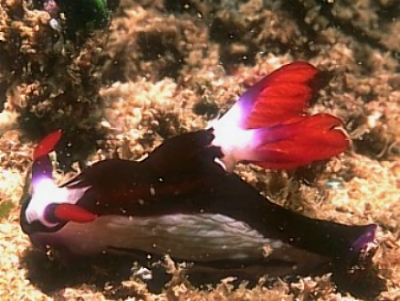
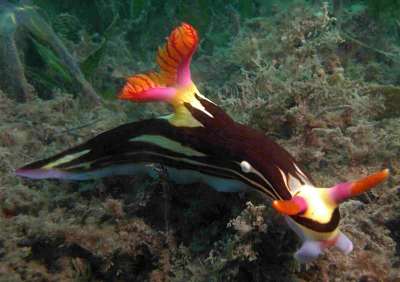
Nembrotha purpureolineata
O'Donoghue, 1924
Order: NUDIBRANCHIA
Suborder: DORIDINA
Family: Polyceridae
Subfamily: Nembrothinae
DISTRIBUTION
Tropical Indo-West Pacific
PHOTO
Upper: Goodwyn Island, Dampier Archipelago, Western Australia. 1986. Length: 5 cm. Photo: Clay Bryce. Lower: Nelson Bay, Port Stephens, NSW., eastern Australia - Pipeline. Depth: 6 metres to 14 metres. Length: 110 - 120 mm. 5 February 2006. Rocky sandy with weeds and algae. Photo: Bruce Potter
Nembrotha purpureolineata, was named from a preserved specimen from Abrolhos Is., Western Australia (O'Donoghue, 1924), but the short colour description is probably enough to identify it to be the same as Nembrotha rutilans Pruvot-Fol, 1931), another poorly described species which was based solely on a painting of marine life from the Great Barrier Reef (Saville-Kent, 1893)[see #21418 ].
The background colour is creamy white, but much of this is obscured by a large brown, charcteristically shaped patch which covers most of the dorsum. There is a brown band running around the head and anterior end of the mantle and there are usually longitudinal brown bands down each side of the body. In some animals the brown patch is broken into a few broad irregular longitudinal patches, and in few instances a number of brown lines. The rhinophore sheaths range from white to pink or purple and often have a dark brown band at the upper edge. The rhinophore clubs are red or orange-red and the stalk is usually pink or purple. The gills are orange or reddish orange and the gill stalks are white often with some pink or purple colouration. The foot is often edged with purple or at least faint traces of purple.
Previously on the Forum this species was identified as N. rutilans and most specimens identified as N. purpureolineata are now identified as the new species N. aurea [see message #21419].
- O'Donoghue, C. H. (1924) Report on Opisthobranchiata from the Abrolhos Islands, Western Australia, with description of a new parasitic copepod. Journal of the Linnean Society, London 35: 521-579, Pls.27-30.
- Pola, M., Cervera, J.L. and Gosliner, T.M. 2008. Revision of the Indo-Pacific genus Nembrotha (Nudibranchia: Dorididae: Polyceridae), with description of two new species. Scientia Marina 72(1): 145-183.
- Pruvot-Fol, A. (1931). Note 10. Nudibranches Australiens figures par Saville Kent. Bull. Mus. Nat. hist. nat. Paris, 2(3): 754-755.
- Wells, F.E. & Bryce, C.W. (1993). Sea Slugs of Western Australia. Western Australian Museum: Perth.
ARCHIVE NOTE: An earlier edition of this Fact Sheet [16 Dec 1998] as nembpurp_16121998.pdf is available on request.
Authorship detailsRudman, W.B., 2008 (March 4) Nembrotha purpureolineata O'Donoghue, 1924. [In] Sea Slug Forum. Australian Museum, Sydney. Available from http://www.seaslugforum.net/find/nembpurp
Related messages
Nembrotha purpureolineata and caprellids
February 17, 2009
From: Valda Fraser
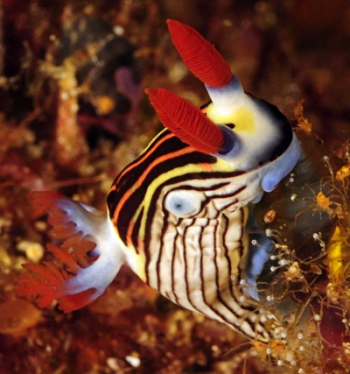
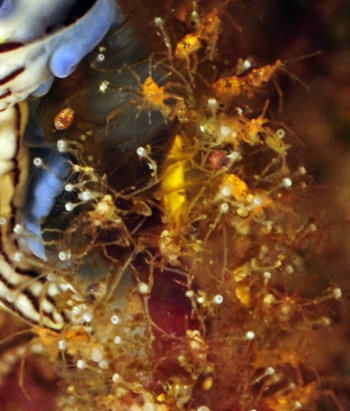
Concerning message #22254:
Dear Bill
I have read your message [#19058 ] on possible caprellid/hydroid symbiosis and was interested in the Caine study where it is reported that when a "nudibranch crawls within a body-length of the amphipod it is aggressively displaced by the caprellid." I attach a photo that appears to link well with this suggestion.
Locality: Park Rynie, 25 m, South Africa, Indian, 11 Jan 2009, Rocky reef. Length: 35 mm. Photographer: Valda Fraser.
Best wishes
Valda
valdafraser@mweb.co.za
Fraser, V.J., 2009 (Feb 17) Nembrotha purpureolineata and caprellids. [Message in] Sea Slug Forum. Australian Museum, Sydney. Available from http://www.seaslugforum.net/find/22259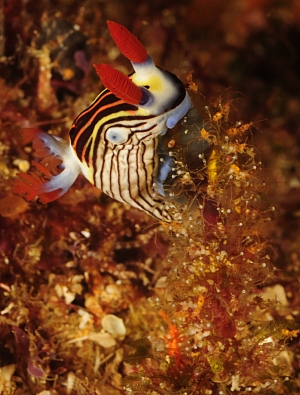
Dear V,
It certainly doesn't look the most comfortable place for the nudibranch to me. Thanks also for the photo of N. purpureolineata. This is the first we have on the Forum of this Sth African colour form.
Best wishes,
Bill Rudman
Abnormality in Nembrotha purpureolineata
March 26, 2008
From: Leanne & David Atkinson
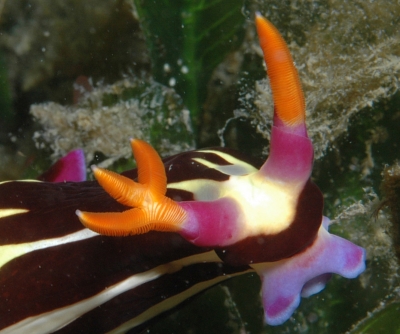
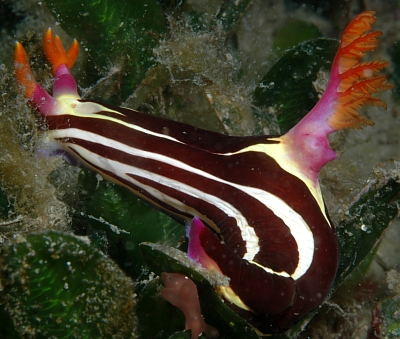
Dear Bill,
We have come across this Nembrotha purpureolineata [formerly N. rutilans] on two dives at The Pipeline recently. It has a trifurcate rhinophore and damaged gills. It seems to be surviving quite nicely finding plenty of yellow lined ascidians to feed on. You didn't have a trifurcate rhinophore on the abnormalities page and this is the first time in over twenty years of diving we have seen this. It seems an appropriate abnormality as one of Neptune's creatures to have a trident shaped rhinophore. Thanks for your interesting work on the SeaSlug Forum we enjoy reading your daily postings and suffer withdrawals evrytime you stop for a while. Hope you had time to finish your projects.
Locality: The Pipeline, Neslon Bay, Port Stephens, 8 metres, New South Wales, Australia, Pacific Ocean, 20 October 2007 & 27 October 2007, Sitly sandy bottom, with scattered ascidians, kelp, algae, seaweed sponges, gorgonians, bryozoans and soft corals. Length: approximately 90 mm. Photographer: Leanne & David Atkinson.
Best wishes,
Leanne & David Atkinson
atk@hunterlink.net.au
Atkinson, L. & D., 2008 (Mar 26) Abnormality in Nembrotha purpureolineata. [Message in] Sea Slug Forum. Australian Museum, Sydney. Available from http://www.seaslugforum.net/find/21059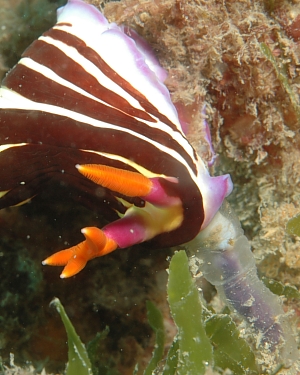
Dear Leanne & David,
Thanks for this. By chance we have a record of Nembrotha kubaryana with a similar trifid rhinophore [message #16715]. Maybe Neptune has a liking for Nembrotha. Your animal also seems to have damage to its gills, the back ones apparently having been bitten off by some predator. I note in the photo alongside, that the Nembrotha is feeding on an ascidian. I guess it is the yellow-lined ascidian, Clavelina meridionalis which you reported on earlier [#15797]. For those of you not familiar with the way Nembrotha feeds, the slugs has inserted it white oral tube [proboscis] into the transparent tube of the ascidian, to eat the brownish body parts.
Best wishes,
Bill Rudman
Nembrotha purpureolineata laying eggs
March 4, 2008
From: Leanne & David Atkinson

Dear Bill,
We found a Nembrotha laying eggs. We weren't sure if it was N. rutilans [= N. purpureolineata], or N. lineolata. There was another one like it a metre away. A few metres further on there were some that we could definitely identify as N. rutilans. Although you could hardly say species of Nembrotha were common to the area the one we see mostly is N. rutilans.
Location: Fly Point, Marine Reserve, Port Stephens, NSW, Australia
Date: 13 March 2004. Depth: 12 metres. Photo:Leanne & David Atkinson
It seems to have damaged gills. There were ascidians that N. rutilans eat nearby.
Thanks for your help,
Leanne & David Atkinson
atk@hunterlink.net.au
Atkinson, L.& D., 2008 (Mar 4) Nembrotha purpureolineata laying eggs. [Message in] Sea Slug Forum. Australian Museum, Sydney. Available from http://www.seaslugforum.net/find/12454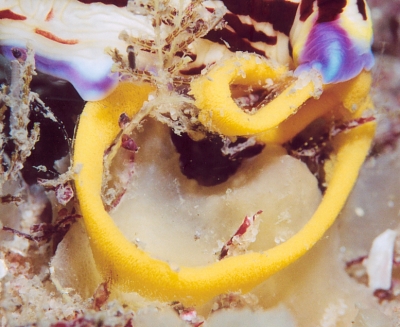
Dear Leanne & David,
As this is an old message I have retrieved from the backlog I have left your usage of N. rutilans which as you will see from today's message [#21419] has changed to N. purpureolineata. Apart from the valuable record of the egg ribbon, it is interesting to get one of these unusual lined variants of the species.
Best wishes
Bill Rudman
Nembrotha rutilans mating in Raja Ampat
June 5, 2007
From: Bob Whorton
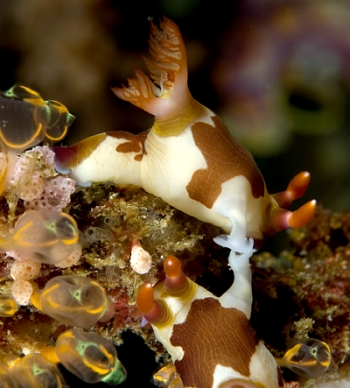
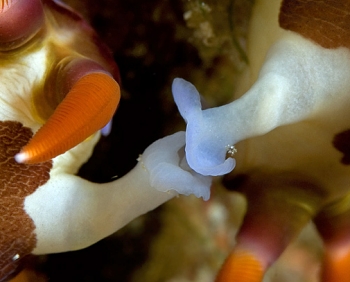
Note added 4 March 2008: Following Pola et al (2008) the name N. rutilans has been replaced by Nembrotha purpureolineata [see message #21419].
Hey Bill, long time, hope you are well.
Here are some shots of Nembrotha rutilans mating on a black coral twig, situated on a south facing shallow sloping reef, of an Island about 30 miles North East of Sorong, Papua, (Iryan Jaya). Shot was taken last December.
My guess is that they bumped into each other on the hunt for tunicates (visible in shot) and made the most of it ...
These small tunicates were prominent, the only variety growing in the area that I noticed during the two dives here. Shots were taken with D200 fitted with a 60 mm lens and the close-up by adding an external diopter.
Conditions grossed out during this capture, current racing at around 2-3 knots. However, they hung on like champions as the twig swayed violently back & forth. Nice detail of the coiled penis visible through the skin.
Locality: Island, 12m, Indonesian Papua, Banda/Halmahera Sea, 12th December 2006, Coral on sandy slope. Length: 5 cm +/-. Photographer: Dr Bob Whorton.
Bob Whorton
drbob.whorton@btinternet.com
Whorton, R., 2007 (Jun 5) Nembrotha rutilans mating in Raja Ampat. [Message in] Sea Slug Forum. Australian Museum, Sydney. Available from http://www.seaslugforum.net/find/19411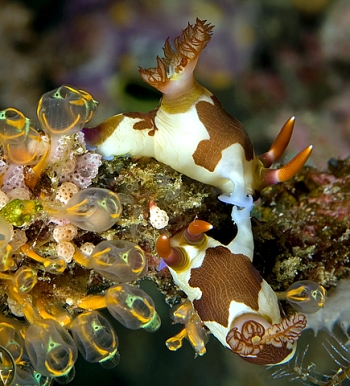
Dear Bob,
Thanks for these shots. I suspect many nudibranchs find their mating partners through their attraction to the same food items
Best wishes,
Bill Rudman
Nembrotha rutilans? from Indonesia
March 5, 2007
From: Aaron Fink
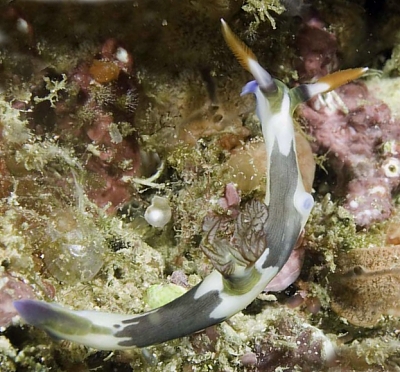
Note added 4 March 2008: Following Pola et al (2008) the name N. rutilans has been replaced by Nembrotha purpureolineata [see message #21419].
I recently took an extensive trip to the Raja Ampat in Indonesia where I encountered a large number of nudibranchs, several of which I was able to capture photographically, but remain unable to identify.
Locality: Wasego Island, 40 ft, Indonesia, Banda - Raja Ampat, 27 October 2007, coral reef. Length: 3 in. Photographer: Aaron Fink.
I am seeking assistance. Many thanks.
Aaron Fink
afink01@comcast.net
Fink, A. S., 2007 (Mar 5) Nembrotha rutilans? from Indonesia. [Message in] Sea Slug Forum. Australian Museum, Sydney. Available from http://www.seaslugforum.net/find/19337Dear Aaron,
Photos like this make me wonder if Nembrotha lineolata and Nembrotha rutilans are just colour forms of one species. Although Nembrotha lineolata, as its name suggests, usually has longitudinal lines down the body, there are plenty of examples showing the lines merging into patches [see message #14679]. I will identify your animal as N. rutilans, but as you will see if you look at earlier messages on these two species, the colour patterns merge, and the reproductive organs seem identical.
Best wishes,
Bill Rudman
Nembrotha rutilans mating from Lembeh Strait
December 5, 2006
From: Mike Krampf
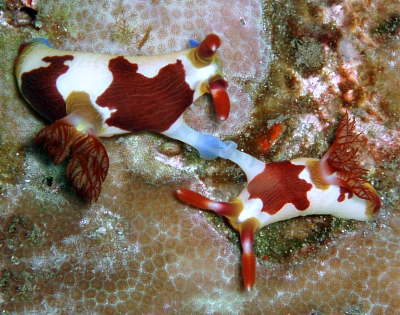
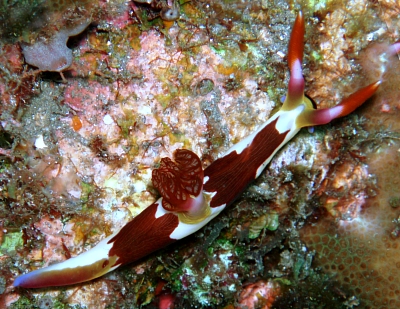
Note added 4 March 2008: Following Pola et al (2008) the name N. rutilans has been replaced by Nembrotha purpureolineata [see message #21419].
Concerning message #18378:
Here is a picture of Nembrotha rutilans mating that was taken in Lembeh Strait. The second picture of the solo Nembrotha rutilans was just a few feet away....maybe waiting his/her turn?
Locality: Lembeh Strait, 30 ft, Indonesia, Celebes Sea, 28 October 2006, Fringing reef. Length: 4 cm. Photographer: Mike Krampf.
Mike
mtkrampf@yahoo.com
Krampf, Mike, 2006 (Dec 5) Nembrotha rutilans mating from Lembeh Strait. [Message in] Sea Slug Forum. Australian Museum, Sydney. Available from http://www.seaslugforum.net/find/18775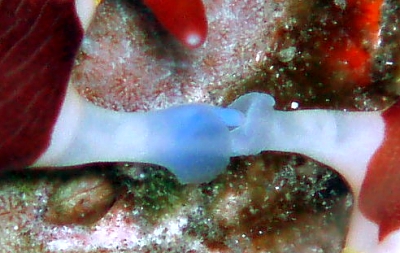
Dear Mike,
Thanks for these photos, which remind me of Roberto Sozzani's photos [#13711]. As I said then, it will be interesting to see if penial shape can be used to distinguish different species. We often used the penis shape of the preserved animal in descriptive work, but its always a bit risky to compare shapes between species because the penis is usually contracted and 'inside out' and often distorted by the preservation process. It's obviously not going to be an easy character to use as it is not often we find mating pairs which are able to be well photographed.
Best wishes,
Bill Rudman
Nembrotha rutilans - feeding observations
February 15, 2006
From: L. & D. Atkinson
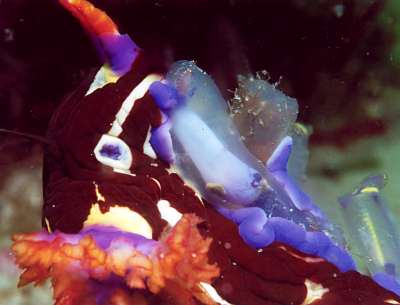

Note added 4 March 2008: Following Pola et al (2008) the name N. rutilans has been replaced by Nembrotha purpureolineata [see message #21419].
Dear Bill,
In your reply to Bruce Potter about Nembrotha rutilans [#15763], you asked whether it might have been feeding on the yellow-lined ascidian, Clavelina meridionalis. We regularly see them feeding on that ascidian, which is abundant in Port Stephens. The accompanying photos were taken in 2004 when we were regularly seeing Nembrotha rutilans at Fly Point. They are less commonly sighted there in late 2004 and are now quite abundant at The Pipeline which is the western end of Nelson Bay Beach. We have been regularly seeing 6 per dive. Clavelina meridionalis is still abundant in both places.
Locality: Fly Point, Marine Reserve, Port Stephens, 14 m, NSW Australia, Pacific, 11 January 2004, Sandy bottom with sponges, soft corals and ascidians. Length: 100 mm Photographer: Leanne & David Atkinson
Regards,
Leanne & David Atkinson
atk@hunterlink.net.au
Atkinson, L. & D., 2006 (Feb 15) Nembrotha rutilans - feeding observations. [Message in] Sea Slug Forum. Australian Museum, Sydney. Available from http://www.seaslugforum.net/find/15797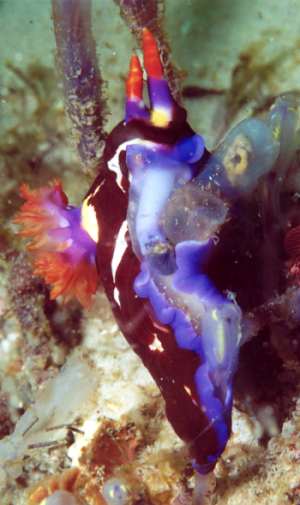
Dear Leanne & David,
Thanks for these great photos. They show very clearly how the white oral tube of the Nembrotha is everted out of the mouth, right into the 'bag-like' branchial cavity of the ascidian so it can feed on the fleshy part of that animal.
Best wishes,
Bill Rudman
Nembrotha purpureolineata or purpureolineolata?
February 10, 2006
From: Roberto Sozzani
Dear Bill,
which is the correct species name? I've seen that the Forum contains both names, many books use N. purpureolineolata as the Forum did in the past [see message #7699], but now all links bring to N. purpureolineata. Can you confirm the last one is the right name?
Thanks
Best wishes
Roberto Sozzani
roberto.sozzani@fastwebnet.it
Sozzani, R., 2006 (Feb 10) Nembrotha purpureolineata or purpureolineolata?. [Message in] Sea Slug Forum. Australian Museum, Sydney. Available from http://www.seaslugforum.net/find/15786Dear Roberto,
Sorry for the confusion on the Forum. I see I have mispelled it purpureolineolata twice on the Forum which I have now corrected. It's not the result of some academic decision just a mistake by me. I am very glad you let me know
Best wishes,
Bill Rudman
Nembrotha rutilans - colour variation
February 8, 2006
From: Bruce Potter
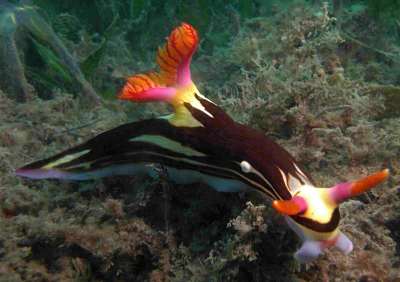
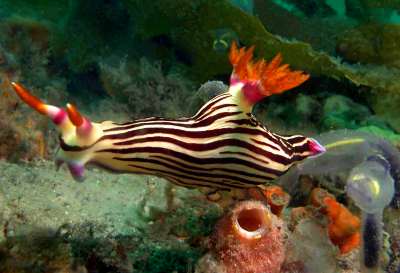
Note added 4 March 2008: Following Pola et al (2008) the name N. rutilans has been replaced by Nembrotha purpureolineata [see message #21419].
Dear Bill,
Nembrotha rutilans are very common at Nelson Bay, and I was interested yesterday to find some with very different markings. I will include three pictures of different animals to show some of the diversity.
Locality: Nelson Bay, Port Stephens, NSW., eastern Australia - Pipeline. Depth: 6 metres to 14 metres. Length: 110 - 120 mm. 5 February 2006. Rocky sandy with weeds and algae. Photographer: Bruce Potter
Regards
Bruce Potter.
bandppotter@bigpond.com
Potter, B., 2006 (Feb 8) Nembrotha rutilans - colour variation. [Message in] Sea Slug Forum. Australian Museum, Sydney. Available from http://www.seaslugforum.net/find/15763
Dear Bruce,
Thanks for these valuable photos. If you read my comments on quite a few of the species of Nembrotha you will see I suspect a number of them are just colour forms of one or a couple of variable species. For example it is possible that N. rutilans is the same as Nembrotha purpureolineata and Nembrotha sp. 1 - and your three photos certainly show that this species ranges from a very lined form to a form in which the purplish lines could almost be described as the background colour.
It is intersting to see the solitary ascidian Clavulina meridionalis (Herdman, 1891) in both the upper two photos. Perhaps it is eaten by this Nembrotha.
Best wishes,
Bill Rudman
Nembrotha rutilans laying eggs
February 6, 2006
From: Leanne & David Atkinson
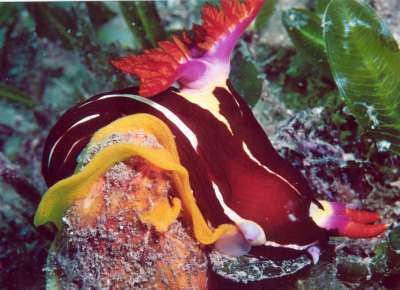
Note added 4 March 2008: Following Pola et al (2008) the name N. rutilans has been replaced by Nembrotha purpureolineata [see message #21419].
Dear Bill,
Here are some photos we took of Nembrotha rutlians laying eggs. It was just a few metres from the entry to The Pipeline dive site. There were six animals within a few metres of each other eating, mating and this one laying eggs. A great start to the New Year!
Locality: The Pipeline, Port Stephens, NSW, AUSTRALIA. Depth: 5 m. Length: approximately 120 mm. 01 January 2006. Sandy bottom scattered ascidians and sponges with seaweed. Photographer: Leanne & David Atkinson
There seem to be a lot of nudibranchs laying eggs at the moment in the Port Stephens area.
Cheers,
Leanne & David Atkinson
atk@hunterlink.net.au

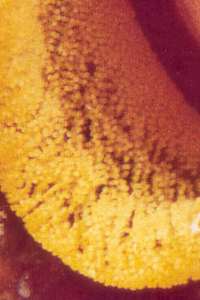
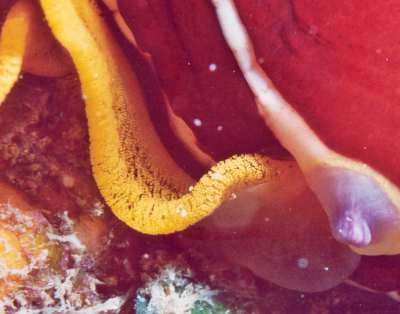
Dear Leanne & David,
Sorry this new year message has been delayed a bit - but I guess the nudies are still abundant. It's really good to get photos of egg-laying individuals as it is helping to build up a basic store of information which we are at present lacking.
Best wishes,
Bill Rudman
Nembrotha rutilans laying eggs - some more details
June 24, 2005
From: Roberto Sozzani
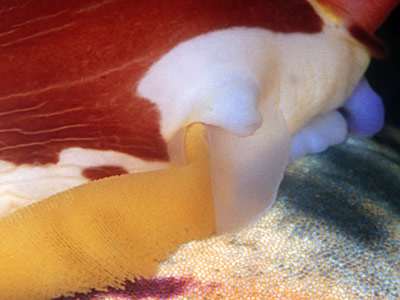
Note added 4 March 2008: Following Pola et al (2008) the name N. rutilans has been replaced by Nembrotha purpureolineata [see message #21419].
Dear Bill,
In your message #13678 you said: "What I am not clear about is where the eggs are extruded. It is possible there is a third opening?"
I found this photo which, maybe, can help to give an answer to your question. It shows an organ extruding eggs. It looks like it is the sexual organ (it has the same position), modified in shape, so that eggs are extruded already as a ribbon. The opening has a height of about 10mm. (near the right rhinophore there is a parasite which has a normal size of 4-5mm. and the opening is about twice that size).
From the photo it's not clear if this could be a third opening or the vagina enlarged for this purpose, but I'm not an expert. I hope this photo can give you some clues about your question.
Locality: Rinja Island, Indonesia. Depth: 12 metres. Length: 7 cm. June 2003
Healthy reef. Photographer: Roberto Sozzani
Best wishes,
Roberto Sozzani
www.robertosozzani.it
roberto.sozzani@fastwebnet.it
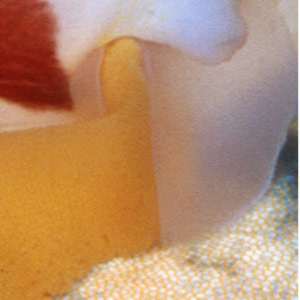
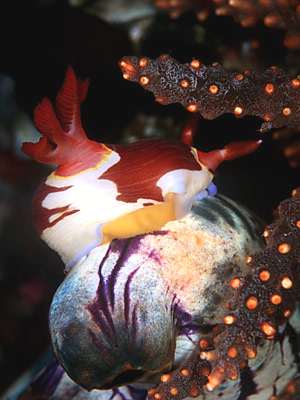
Dear Roberto,
Thanks very much. This does indeed answer my question. Most dorid nudibranchs have what we call a triaulic reproductive system in which the incoming and outgoing sperm, and outgoing egg ribbon all have separate ducts. Usually the incoming sperm and outgoing eggs share a 'female opening'. The openings are usually contained in a small genital pouch or vestibule which swells into a small mound during mating. I can't think of another group, other than these nembrothids, in which the vestibule has developed into such a large and elaborate organ. Because of this I wondered whether the egg-laying duct may have a separate opening at the base of this organ, something we could not necessarily see when dissecting a preserved animal in which this organ would not be expanded.
Your photo shows that the eggs also go right to the end of this mating organ as well, and the opening is greatly stretched to accommodate the wide egg ribbon.
Best wishes,
Bill Rudman
Nembrotha rutilans eating tunicate
June 9, 2005
From: Bob Whorton
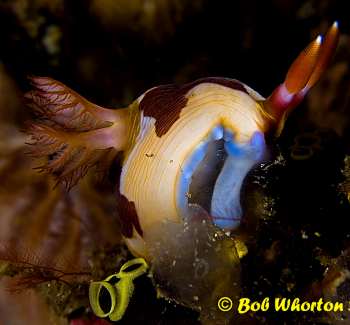
Note added 4 March 2008: Following Pola et al (2008) the name N. rutilans has been replaced by Nembrotha purpureolineata [see message #21419].
Hi Bill,
Thought you may be interested in these examples of Nembrotha rutilans munching on a tunicate...
Images were taken outside Wori Bay in Sulawesi, just north of Manado in May.
Locality: Wori Bay, Lembeh Strait, Sulawesi, Indonesia. Depth: +/- 6M
Length: 4". May 2005. Coral Reef. Photographer: Dr Bob Whorton.
What was interesting for me was watching the event unfurl and the lengths it can extend it's mouth parts to eat the tunicate from the inside out, bypassing the outer protection.
Hope they are useful to others too.
Cheers,
Bob Whorton
England.
drbob.whorton@btinternet.com
Whorton, R., 2005 (Jun 9) Nembrotha rutilans eating tunicate. [Message in] Sea Slug Forum. Australian Museum, Sydney. Available from http://www.seaslugforum.net/find/13941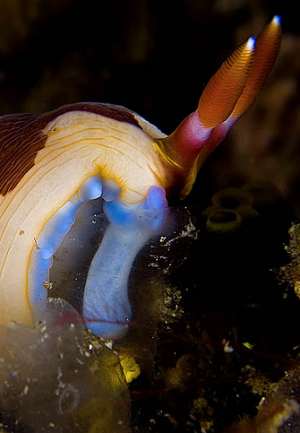
Dear Bob,
Thanks for these interesting photos. The long blue tube from the head to the ascidian is the oral tube which, when not in use, sits retracted into the body cavity. At its tip is the radular ribbon, a 'tongue' of teeth used in biting off pieces of its food.
Best wishes,
Bill Rudman
Re: Nembrotha rutilans mating
May 11, 2005
From: Roberto Sozzani
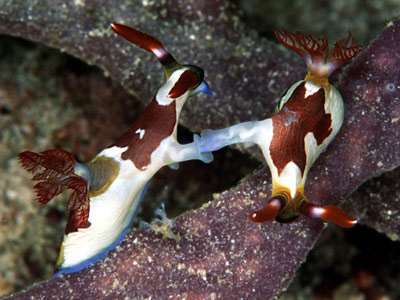

Note added 4 March 2008: Following Pola et al (2008) the name N. rutilans has been replaced by Nembrotha purpureolineata [see message #21419].
Dear Bill,
Following my previous message [#13711], here is another couple of Nembrotha rutilans mating. This photo confirms that in this species, penis is on the side and vagina at centre and also shows how much the genitalia organ can be extended, compared to other species.
Locality: Irian Jaya, Indonesia. Depth: 12 metres. Length: 6 cm. February 2002. Sand and coral slope. Photographer: Roberto Sozzani
Best regards
Roberto Sozzani
www.robertosozzani.it
roberto.sozzani@fastwebnet.it
Sozzani, R., 2005 (May 11) Re: Nembrotha rutilans mating. [Message in] Sea Slug Forum. Australian Museum, Sydney. Available from http://www.seaslugforum.net/find/13745Thanks Roberto,
Bill Rudman
Nembrotha rutilans mating
May 5, 2005
From: Roberto Sozzani
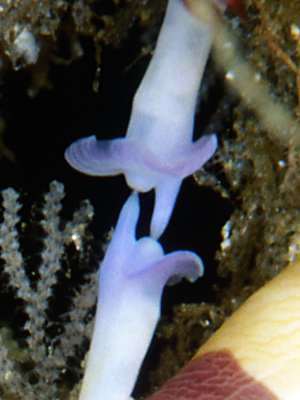
Note added 4 March 2008: Following Pola et al (2008) the name N. rutilans has been replaced by Nembrotha purpureolineata [see message #21419].
Dear Bill,
Following my previous message [#13678], I add this photo with penis details of Nembrotha rutilans. As you can see, there are some differences, compared to Nembrotha purpureolineolata.
Locality: Irian Jaya, Indonesia. Depth: 12 metres. Length: 7 cm. February 2002. Corals and sand. Photographer: Roberto Sozzani
About the opening for laying eggs, I'll check all my photos to find some clues...
Best regards
Roberto Sozzani
www.robertosozzani.it
roberto.sozzani@fastwebnet.it
Sozzani, R., 2005 (May 5) Nembrotha rutilans mating. [Message in] Sea Slug Forum. Australian Museum, Sydney. Available from http://www.seaslugforum.net/find/13711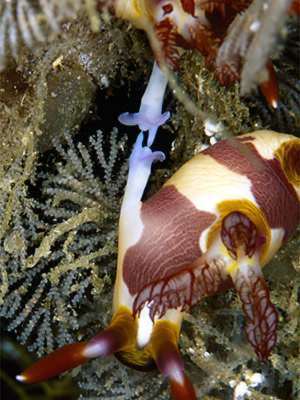
Dear Roberto,
Thanks again. In this case the vaginal opening is in the centre and the penis is off to the side. In insects, differences in the shape of the genitalia are very useful characters in distinguishing species, because they are chitinous structures with a permanent shape even after preservation. In nudibranchs, all these differences usually disappear when the animal is preserved. Good luck in looking through your photos. It would be interesting to see if the shape of the everted genitalia were different in all species of Nembrotha.
This is a good example. I have difficulty deciding the difference between N. rutilans and some similarly coloured species such as N. chamberlaini. Your animal is rather differently coloured than say the ones in Dave Harasti's message [#9767] but the genitalia are identical. I know it is possible that similarly coloured species may have the same genital morphology, but it looks as though it could be useful - if difficult - character.
Marta Pola, who is studying these animals at present may have some thoughts ...
Best wishes,
Bill Rudman
Nembrotha rutilans mating
January 30, 2004
From: Dana Africa
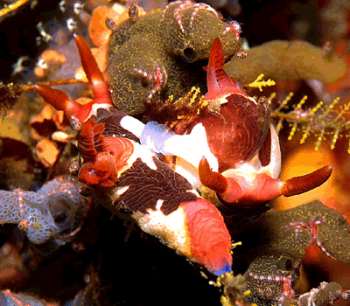
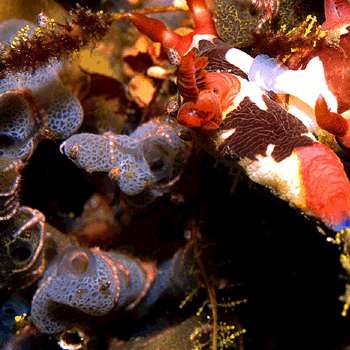
Note added 4 March 2008: Following Pola et al (2008) the name N. rutilans has been replaced by Nembrotha purpureolineata [see message #21419].
Dear SeaSlug Forum
While scuba diving between Komodo Island and Alor Island in the Indonesian chain, I came across a pair of mating nudibranchs with personal parts showing AND a tiny fish watching on one of them.
Best wishes
Dana Africa
AfriDiver@aol.com
Africa, D., 2004 (Jan 30) Nembrotha rutilans mating. [Message in] Sea Slug Forum. Australian Museum, Sydney. Available from http://www.seaslugforum.net/find/12057Dear Dana,
I'm afraid the fish escapes me but the ascidians clustered may be a food item for Nembrotha
Best wishes
Bill Rudman
Nembrotha rutilans on the Great Barrier Reef
January 8, 2004
From: Paul Osmond
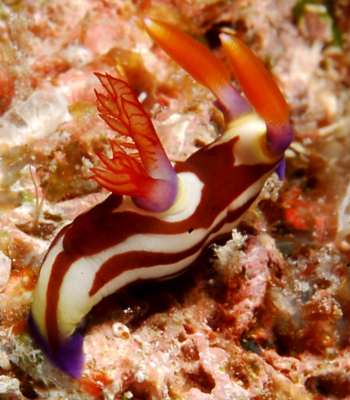
Note added 4 March 2008: Following Pola et al (2008) the name N. rutilans has been replaced by Nembrotha purpureolineata [see message #21419].
I believe this is Nembrotha chamberlaini found on the Great Barrier Reef off the coast of Townsville, Queensland in October 2003 although it does appear to be outside its stated range.
We found three separate indivduals on one reef at about 20m of depth.
Thanks,
Paul
marriard@deepseaimages.com
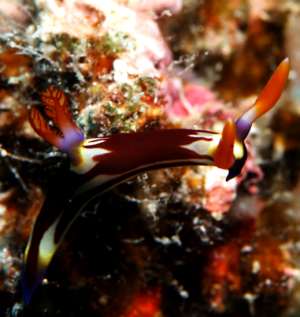
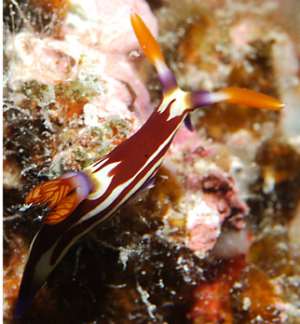
Dear Paul,
One of the aims of the Forum is to find things outside 'their stated range'. The 'known range' of most species tends to reflect our lack of knowledge so don't hesitate to suggest we are wrong.
However I would identify this species as Nembrotha rutilans rather than as Nembrotha chamberlaini, but I think we have some way to go before we can be confident about stating how many species there are in this group. We either have one quite variable species or a group of similarly coloured species.
Best wishes
Bill Rudman
Nembrotha rutilans from Bali?
August 29, 2003
From: Jukka-Pekka Salmenkaita
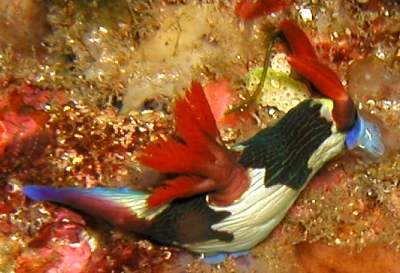
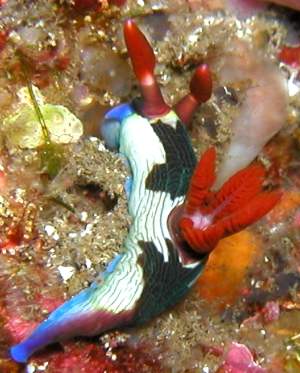
Note added 4 March 2008: Following Pola et al (2008) the name N. rutilans has been replaced by Nembrotha purpureolineata [see message #21419].
Dear Bill,
I photographed this specimen in Biaha, Candidasa, Bali, Indonesia in 25th July 2002. Is it Nembrotha rutilans? It could have been eating that small bluish ascidian(?).
Best regards,
Jukka-Pekka
jsalmenk@cc.hut.fi
Salmenkaita, J-P., 2003 (Aug 29) Nembrotha rutilans from Bali?. [Message in] Sea Slug Forum. Australian Museum, Sydney. Available from http://www.seaslugforum.net/find/10620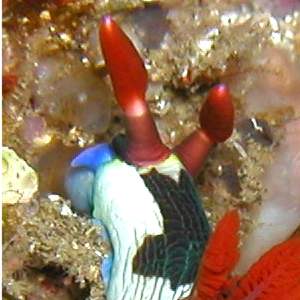
Dear Jukka-Pekka,
Yes this is N. rutilans. I am pretty sure it is eating one of the translucent white ascidians which seem quite abundant in your photo. The bluish thing you can see is the slug's oral tube which everts out of the mouth during feeding. At the end of it is the slug's radular teeth which bite off chunks of the ascidian and drag them into its mouth.
Best wishes,
Bill Rudman
re: Nembrotha rutilans at Fly Point
April 25, 2003
From: Dave Harasti
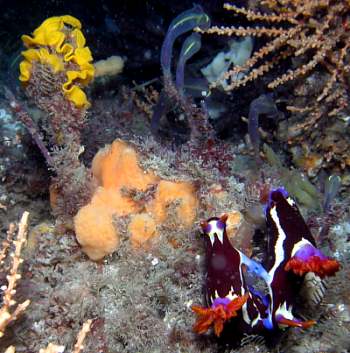
Note added 4 March 2008: Following Pola et al (2008) the name N. rutilans has been replaced by Nembrotha purpureolineata [see message #21419].
Hi Bill,
Following my last message I took some photo's today of the Nembrotha's mating at Fly Point, Nelson Bay [Port Stephens, NSW, Australia]. This same pair has now been around for 7 weeks.
On each occasion I have seen this pair, there has been a yellow egg ribbon in close proximity. I am 100% sure this has been laid by Nembrotha rutilans as they are always found near this egg mass.
Cheers,
David
diving@webone.com.au
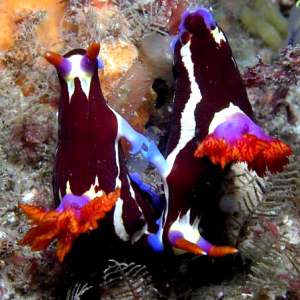

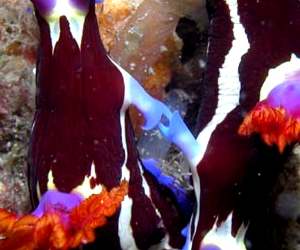
Thanks Dave,
Your upper photo looks like a Nembrotha paradise - with even a few of the yellow-lined ascidians nearby if they get hungry. I have included a close-up alongside showing the copulatory organs in action. As these animals are hermaphrodite both partners receive sperm from the other. In many nudbranchs the female opening [vagina] is just an opening on the right side of the body, sometimes raised on a slight swelling but often not. In at least some species of Nembrotha, as is so well illustrated here, the vaginal opening and the penial papilla are at the end of a long stalk, which is everted during mating.
Best wishes,
Bill Rudman
Nembrotha rutilans from Nelson Bay, Australia
April 19, 2003
From: Dave Harasti
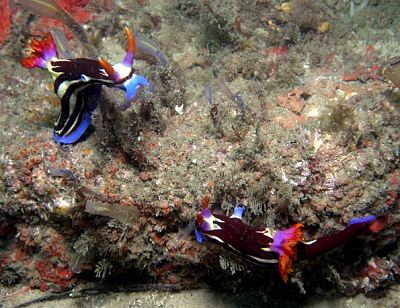
Note added 4 March 2008: Following Pola et al (2008) the name N. rutilans has been replaced by Nembrotha purpureolineata [see message #21419].
Hi Bill,
Just thought I'd share a couple of pics of Nembrotha rutilans from Fly Point at Nelson Bay, NSW - Australia. This pair have been in the same location for about a month [March/April 2003] and I have seen them mating and laying eggs. This is now officially my favourite nudibranch species.
Cheers,
Dave
diving@webone.com.au
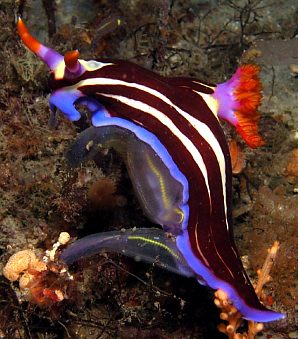
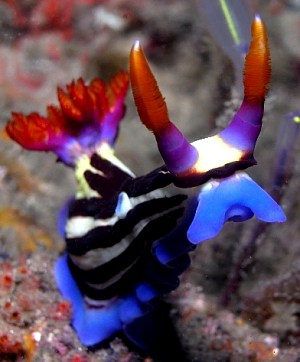
Thanks Dave,
In your upper photo the left animal is crawling on a solitary ascidian, Clavelina meridionalis (Herdman, 1891) which is quite easily recognised by its stalk, and the yellow streak in the 'body'. It has obviously found a little group of this ascidian which I suspect it is eating. In your lower left photo it is crawling over two of them. From the other messages on the Forum, N. rutilans seems to have a taste for a variety of ascidians. I was interested in your comment about them mating and laying eggs. Were the eggs the same as those illustrated in David & Leanne Atkinson's photo?
Bst wishes.,
Bill Rudman
Nembrotha rutilans from Sydney
January 24, 2003
From: Paul Selwood

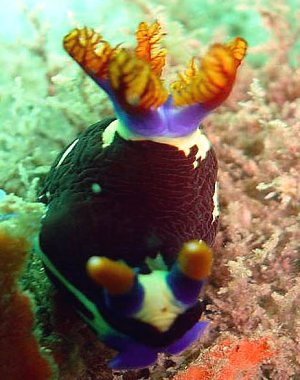
Note added 4 March 2008: Following Pola et al (2008) the name N. rutilans has been replaced by Nembrotha purpureolineata [see message #21419].
Hi,
I got pointed to your site by a friend and what a fantastic resource it is! Could you please confirm the i.d. of these little Nudis doing "the wild thing" for me, I found them at Kurnell in Sydney on December 8 2002 in approx 10m of water, my friend has i.d'd them as Purple-Lined Nembrotha [Nembrotha purpureolineata] would that be correct?
Thanks,
Paul
paul@scubakiwi.net
Selwood, P., 2003 (Jan 24) Nembrotha rutilans from Sydney. [Message in] Sea Slug Forum. Australian Museum, Sydney. Available from http://www.seaslugforum.net/find/8906Dear Paul,
Welcome to the Forum and thanks for this interesting record. This is Nembrotha rutilans, but as you will see if you read some of my comments on this and N. purpureolineata, there is some confusion concerning just how to separate some of these 'species'. Of particular interest is where you found it. To my knowledge this is the furthest south it has been seen, although it has been seen once or twice in Port Stephens, further up the New South Wales coast. It is clearly another tropical species which occasionally drifts down the New South Wales coast, and if conditions are right, settles and grows to maturity.
Best wishes,
Bill Rudman
Nembrotha rutilans juvenile feeding
January 17, 2003
From: Danny Van Belle
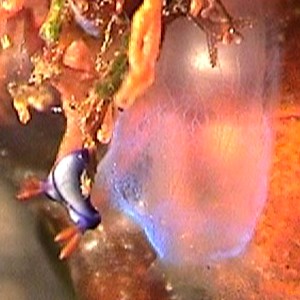
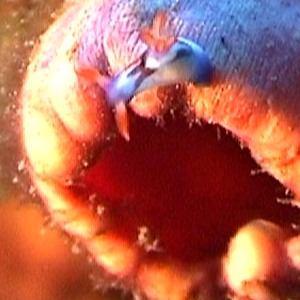
Note added 4 March 2008: Following Pola et al (2008) the name N. rutilans has been replaced by Nembrotha purpureolineata [see message #21419].
Hi Bill,
I filmed this very small Nembrotha rutilans? feeding on a tunicate. I think it's a juvenile.
This one also was more bluish on it's body compared to the bigger ones!
Danny Van Belle
dannyvb@hotmail.com
Van Belle, D., 2003 (Jan 17) Nembrotha rutilans juvenile feeding. [Message in] Sea Slug Forum. Australian Museum, Sydney. Available from http://www.seaslugforum.net/find/8845Thanks Danny,
As you may have guessed, if you have looked at some of the correspondence on this and similarly coloured 'species', such as N. purpureolineata, I have some difficulty in separating some of these species, especially the juveniles. Since you have suggested Nembrotha rutilans, I am happy to go along with that, but we may be wrong. I am surprised your animals are showing an interest in such relatively large ascidians.
Best wishes,
Bill Rudman
Nembrotha rutilans from Nelson Bay
January 15, 2003
From: Allan Saben
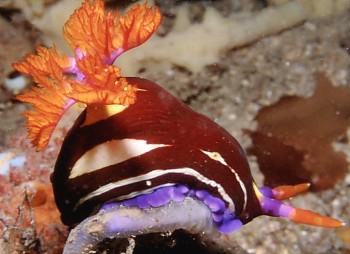
Note added 4 March 2008: Following Pola et al (2008) the name N. rutilans has been replaced by Nembrotha purpureolineata [see message #21419].
Hi Bill,
Happy New Year, I just got back from Nelson Bay, Port Stephens [Halifax and Flypoint divesites, New South Wales, Australia]. Here are a few more images of animals I have taken [December 2002].
Here is Nembrotha rutilans.
Enjoy,
Allan Saben
asaben@bigpond.net.au
Saben, A., 2003 (Jan 15) Nembrotha rutilans from Nelson Bay. [Message in] Sea Slug Forum. Australian Museum, Sydney. Available from http://www.seaslugforum.net/find/8871Thanks Allan,
Bill Rudman
Nembrotha rutilans from Borneo
December 31, 2002
From: Mark Burnett
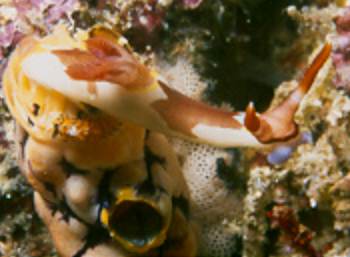
Note added 4 March 2008: Following Pola et al (2008) the name N. rutilans has been replaced by Nembrotha purpureolineata [see message #21419].
Hi Bill,
Here is a photo of Nembrotha rutilans on an ascidian which I photographed on a trip to Mabul, Borneo. Note the very small nudibranch which I identified it as Favorinus tsuruganus. It is the subject of a separate message.
Mark Burnett
mburnett@actrix.gen.nz
Burnett, M., 2002 (Dec 31) Nembrotha rutilans from Borneo. [Message in] Sea Slug Forum. Australian Museum, Sydney. Available from http://www.seaslugforum.net/find/8763Thanks Mark,
I've split this photo from your Favorinus tsuruganus message as it shows the blue oral lappets very well. At this stage, while we are still sorting out colour variations in this group of species, it is good to keep a record of colour details like this - they may turn out to be useful later.
Best wishes,
Bill Rudman.
Nembrotha rutilans feeding
November 1, 2002
From: Sabine Noack
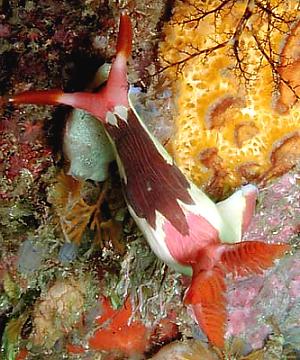
Note added 4 March 2008: Following Pola et al (2008) the name N. rutilans has been replaced by Nembrotha purpureolineata [see message #21419].
Dear Bill,
Here are 3 pictures of Nembrotha rutilans looking for its favorite tunicates and feeding on them.
Location: Cannibal Rock, Horseshoe Bay, Rinca, Indonesia
Depth: 12m
Date/Time: 29.9.2001, 14:20
Size: ~ 5cm
Sabine
dive@snoack.de
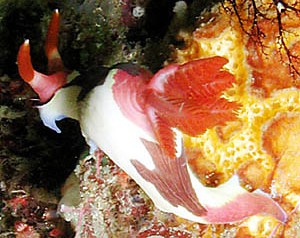
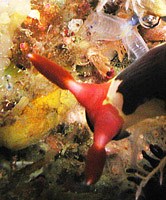
Thanks Sabine,
A very nice observation
Bill Rudman
Juvenile? Nembrotha from North Sulawesi
October 6, 2002
From: Marli Wakeling
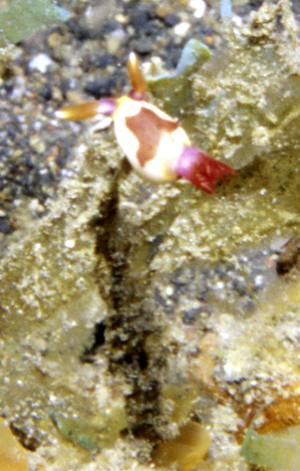
Note added 4 March 2008: Following Pola et al (2008) the name N. rutilans has been replaced by Nembrotha purpureolineata [see message #21419].
Hi Bill,
Here is a tiny Nembrotha - like juvenile, found on a night dive in Lembeh Straight. Do you have any idea as to its ID?
Location: Jahir, Lembeh Straight, North Suluwesi, Indonesia.
Date: July, 2002
Depth: 30 feet
Length: 5mm
Photograph: Marli Wakeling
Regards,
Marli
scubamarli@excite.com
Dear Marli,
From its colour pattern I would say this is Nembrotha rutilans.
Best wishes,
Bill Rudman
Nembrotha rutilans? from Malaysia
September 16, 2002
From: Richard Houghton
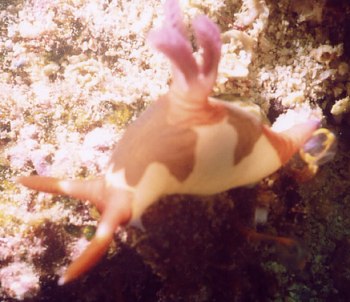
Note added 4 March 2008: Following Pola et al (2008) the name N. rutilans has been replaced by Nembrotha purpureolineata [see message #21419].
I think this creature may be Nembrotha rutilans, but really not too sure.
It was on the bottom of a reef slope in between the last hard corals before a flat sandy sea bed took over. Kapalai Island, Malaysia, August 2002.
Unfortunately it was in a tricky position, so the photo is not the best from which to identify the species.
Best regards,
Rich
richard_houghton@hotmail.com
Houghton, R., 2002 (Sep 16) Nembrotha rutilans? from Malaysia. [Message in] Sea Slug Forum. Australian Museum, Sydney. Available from http://www.seaslugforum.net/find/7849Dear Rich,
As you will see from other messages, there is quite a bit of confusion surrounding this and a number of other names. Yours certainly fits Nembrotha rutilans.
Best wishes,
Bill Rudman
Nembrotha rutilans feeding
May 11, 2002
From: Mary Jane Adams
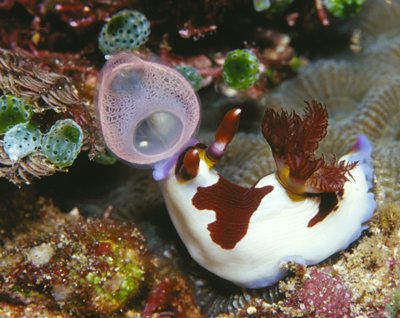
Note added 4 March 2008: Following Pola et al (2008) the name N. rutilans has been replaced by Nembrotha purpureolineata [see message #21419].
Hi Bill,
When I first noticed this Nembrotha rutilans, it was crawling across the reef. As I was watching, it stopped under the pink ascidian, raise it's head, felt around a little with it's mouth, and then began to feed. I got the definite impression that it had detected food before making actual contact with it.
Divesite: Angel's Window, Lembeh
Island, Indonesia. April 12, 2002
Best regards,
Mary Jane
divepng@yahoo.com
Adams, M J., 2002 (May 11) Nembrotha rutilans feeding. [Message in] Sea Slug Forum. Australian Museum, Sydney. Available from http://www.seaslugforum.net/find/6880Dear Mary Jane,
I hope you went and bought a lottery ticket afterwards. If you had really wanted to take a photo of it feeding it would have taken weeks! Concerning its identity. The more I see of these animals the more unsure of their identity I become. It certainly has the large brown block of colour found in N. rutilans but if it was broken into brown lines it would look much like N. purpureolineata or even P. lineolata.
Best wishes,
Bill Rudman
Nembrotha rutilans feeding
September 20, 2001
From: Mary Jane Adams

Note added 4 March 2008: Following Pola et al (2008) the name N. rutilans has been replaced by Nembrotha purpureolineata [see message #21419].
Hi Bill,
I think this slug most closely resembles the pattern of Nembrotha rutilans. I watched it crawl around for several minutes before it bumped into the white tunicate and began eating it. Length: about 5 cm.
Divesite: Batu sandar, Lembeh Straits, Sulawesi, Indonesia, August 15, 2001.
Best regards,
Mary Jane
divepng@yahoo.com
Adams, M.J., 2001 (Sep 20) Nembrotha rutilans feeding. [Message in] Sea Slug Forum. Australian Museum, Sydney. Available from http://www.seaslugforum.net/find/5284Thanks Mary Jane,
Bill Rudman
Nembrotha rutilans from Mozambique
May 4, 2001
From: Valda Fraser
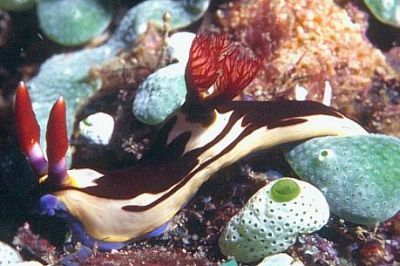
Note added 4 March 2008: Following Pola et al (2008) the name N. rutilans has been replaced by Nembrotha purpureolineata [see message #21419].
Dear Bill
I am sending you this photograph on behalf of a friend, Dennis King. Can you help with identification? I would think that this is either Nembrotha purpureolineolata or N. rutilans.
Thanks.
Locality: Mozambique - 15m
Date: June 2000
Size: 4 cm
Regards
Valda
nunu30
valdafraser@mweb.co.za
Fraser, V., 2001 (May 4) Nembrotha rutilans from Mozambique. [Message in] Sea Slug Forum. Australian Museum, Sydney. Available from http://www.seaslugforum.net/find/4212Dear Valda,
As you will have seen in my comments about both those species, I suspect they may be colour forms of each other. This animal fits the colour pattern of N. rutilans but if they do turn out to be one species then N. purpureolineata is the older name.
Best wishes,
Bill Rudman
Re: Nembrotha rutilans
September 23, 2000
From: Jeremy Rose
Note added 4 March 2008: Following Pola et al (2008) the name N. rutilans has been replaced by Nembrotha purpureolineata [see message #21419].
Bill,
Many thanks for your reply. Your site is absolutely fascinating and very informative.
Regards,
Jeremy
jerry@photobase.co.uk
Rose, J., 2000 (Sep 23) Re: Nembrotha rutilans. [Message in] Sea Slug Forum. Australian Museum, Sydney. Available from http://www.seaslugforum.net/find/3069Nembrotha rutilans from Sydney
September 21, 2000
From: A. Lumnitzer & D. Piotrowska
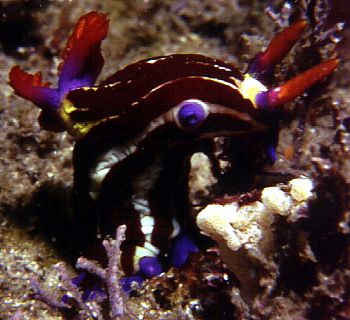
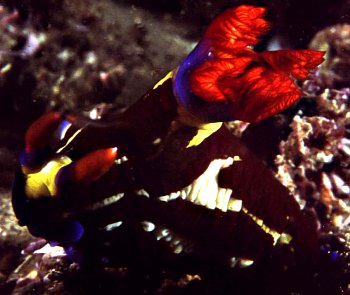
Note added 4 March 2008: Following Pola et al (2008) the name N. rutilans has been replaced by Nembrotha purpureolineata [see message #21419].
Dear Bill,
We had this Nembrotha at Oak Park [Sydney, Australia] in 6m of water for about six months, from November 1999 to around late May this year. Is it N. rutilans or N. purpureolineolata. Check out the colour of the genital opening in the upper photo.
The slug was about 100mm long.
Best wishes
Akos & Donata
dna72@softhome.net
Lumnitzer, A. & Piotrowska, D., 2000 (Sep 21) Nembrotha rutilans from Sydney. [Message in] Sea Slug Forum. Australian Museum, Sydney. Available from http://www.seaslugforum.net/find/3046Dear Akos & Donata,
Thanks for the photos. You ask whether it is N. rutilans or N. purpureolineolata. A good question. probably the right question to ask is whether the two species are just colour variants of one species.
Best wishes,
Bill Rudman.
Nembrotha rutilans in aquarium
September 19, 2000
From: Jeremy Rose

Note added 4 March 2008: Following Pola et al (2008) the name N. rutilans has been replaced by Nembrotha purpureolineata [see message #21419].
I came across David & Leanne's posting.
Interestingly enough I have just purchased a N. rutilans from a local marine shop here in London, UK. It was so amazing I just had to get it for my reef tank.
Because of the posting (and others) I have been able to identify the species.
Some things happened
10th September Placed in the tank
11th September Chevron Tang and Sweet Lips died (I don't know if there is any connection)
12th September it climbed up a red Gorgonia and laid a yellow tissue like ribbon. I had no idea what was happening although I thought it might be laying. Your posting clarified this. Yellow Tang had a little taster of the ribbon.
13th September both ribbon and N. rutilans are still up the Gorgonia.
Questions:
Is it poisonous?
What happens to the ribbon - do little ones hatch from it? If so, how long does it take and what should I do?
Jeremy Rose
jerry@photobase.co.uk

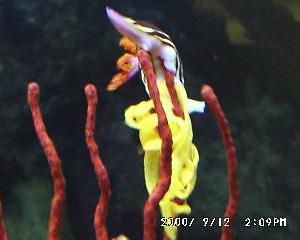
Dear Jeremy,
Is your Nembrotha poisonous to your fish? Did it kill them? I'm not sure. Many nudibranchs have nasty chemicals in their skins for defence. These are usually obtained from their food, either directly or as a molecule which they can easily alter. Ascidians (sea squirts, tunicates), which species of Nembrotha eat, do have defensive chemicals, and species of Nembrotha do produce secretions from their skin. So it is possible that they could have killed you fish, but I don't know of any experimental observations to show that they can. Certainly species of Phyllidia and related genera are not good company in an aquaria, because they do produce toxic secretions.
As you say, the ribbon is an egg ribbon. Often nudibranchs when they are stressed, lay an egg-ribbon almost as though they know they might not have long to survive and should attempt to perpetuate their species. If the eggs are fertile they will produce tiny free-swimming veliger larvae, which without a lot of care will almost certainly not survive aquarium life.
The other bad news is that most nudibranchs have very specialised diets. In the case of species of Nembrotha, each species eats one, or a few, species of ascidian. Even if you could buy the specific species of ascidian, the chances of keeping it alive in your aquarium as food for your Nembrotha are very slight.
Best wishes,
Bill Rudman.
Nembrotha rutilans feeding
January 22, 2000
From: David & Leanne Atkinson
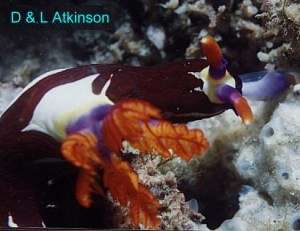
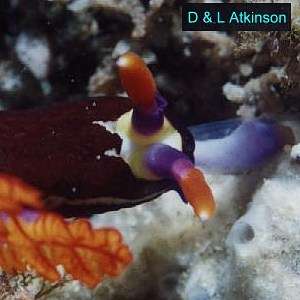
Note added 4 March 2008: Following Pola et al (2008) the name N. rutilans has been replaced by Nembrotha purpureolineata [see message #21419].
Hi there,
We found our resident Fly Point Nembrotha "sticking out its tongue". Is it projecting its radula to eat? It was like this for at least 15 minutes and didn't move. Any ideas ?
[Fly Point, Port Stephens, New South Wales, Australia]
David & Leanne Atkinson
atkin@hunterlink.net.au
Atkinson, D. & L., 2000 (Jan 22) Nembrotha rutilans feeding. [Message in] Sea Slug Forum. Australian Museum, Sydney. Available from http://www.seaslugforum.net/find/1767Dear David & Leanne,
Thanks for the interesting photograph. Yes your Nembrotha is not being rude to the photographer but is sticking out its 'proboscis'-like oral tube so that the radular teeth can 'bite' its food. I presume the Nembrotha will be feeding on an ascidian or sea-squirt - either solitary or colonial - so it would be worth trying to identify where the proboscis is actually spending its time.
Best wishes,
Bill Rudman.
Nembrotha rutilans from Port Stephens
July 14, 1999
From: Grey McNeil
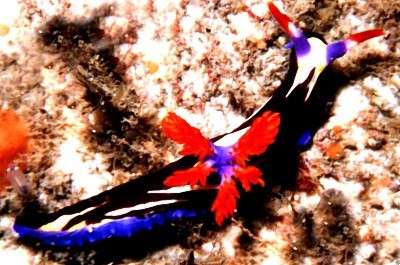
Note added 4 March 2008: Following Pola et al (2008) the name N. rutilans has been replaced by Nembrotha purpureolineata [see message #21419].
Dear Bill,
Could you identify this photo please. The details are:
PIPELINE, NELSON BAY, Port Stephens, NSW, eastern Australia, 7m, June 1999, 2cm long.
Thanks,
Grey McNeil.
GREYMACIND@bigpond.com.au
McNeil, G., 1999 (Jul 14) Nembrotha rutilans from Port Stephens. [Message in] Sea Slug Forum. Australian Museum, Sydney. Available from http://www.seaslugforum.net/find/1006Dear Grey,
This spectacular animal is Nembrotha rutilans. There are a number of species with very similar colour patterns (see Top of Page). It will take further research before we can confidently say which are separate species. Any help with biological information, through photos of what they are feeding on, or colour and shape of egg mass etc coulod be very useful if the internal anatomy doesn't help.
Bill Rudman.
Rudman, W.B., 1999 (Jul 14). Comment on Nembrotha rutilans from Port Stephens by Grey McNeil. [Message in] Sea Slug Forum. Australian Museum, Sydney. Available from http://www.seaslugforum.net/find/1006Nembrotha rutilans
July 2, 1999
From: Bill Rudman
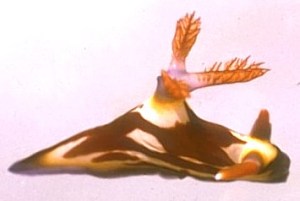
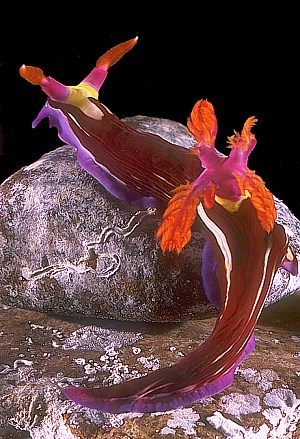
Note added 4 March 2008: Following Pola et al (2008) the name N. rutilans has been replaced by Nembrotha purpureolineata [see message #21419].
This species was unfortunately named by Pruvot-Fol on the basis of a painting in a book by William Saville-Kent, (1893) entitled "The Great Barrier Reef of Australia". (Colour Plate 13, fig. 9 - Ancula sp.. The species can only be identified from the colour painting. The animal in the painting has almost identical markings to the Broadhurst Reef photo here. The major differences are that in the painting the background colour is all yellow, rather than white with a diffuse yellow edge. The gills in the painting are characteristically large as in the photos shown here. Another "species" with very similar colour is Nembrotha purpureolineata which was first described from Western Australia.
Upper: Broadhurst Reef, Townsville, Queensland, September 1974. Photo: Ian Loch. Lower: Fly Point, Port Stephens, central New South Wales, Australia, July 1990. Approx 120 mm long. Photo: Bill Rudman.
-
Pruvot-Fol, A. (1931). Note 10. Nudibranches Australiens figures par Saville Kent. Bull. Mus. Nat. hist. nat. Paris, 2(3): 754-755.
Best wishes
Bill Rudman
Nembrotha rutilans mating
April 15, 1999
From: David & Leanne Atkinson

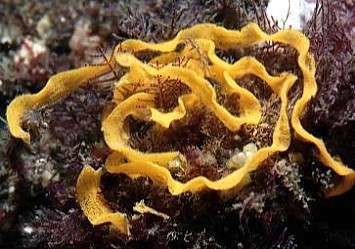
Note added 4 March 2008: Following Pola et al (2008) the name N. rutilans has been replaced by Nembrotha purpureolineata [see message #21419].
Hi Bill,
Here is another photo from our busy diving over Easter.
We found some Nembrotha mating at Fly Point in 12m. [Port Stephens, New South wales, Australia]. Also, (I think) found
nearby Nembrotha eggs.
David & Leanne Atkinson
atkin@hunterlink.net.au
Atkinson, D. & L., 1999 (Apr 15) Nembrotha rutilans mating. [Message in] Sea Slug Forum. Australian Museum, Sydney. Available from http://www.seaslugforum.net/find/774Dear David & Leanne,
What a great photo of Nembrotha rutilans mating. When I get round to doing a page on mating can I use your picture please? The eggs are certainly not inconsistent with a species of Nembrotha but the only way to be sure is to catch an animal actually laying an egg mass.
Thanks again,
Bill Rudman.
